
Medium wave (MW) is the part of the medium frequency (MF) radio band used mainly for AM radio broadcasting. The spectrum provides about 120 channels with limited sound quality. During daytime, only local stations can be received. Propagation in the night allows strong signals within a range of about 2000 km. This can cause massive interference because on most channels, about 20 to 50 transmitters operate simultaneously worldwide. In addition to that, amplitude modulation (AM) is prone to interference by all sorts of electronic devices, especially power supplies and computers. Strong transmitters cover larger areas than on the FM broadcast band but require more energy. Digital modes are possible but have not reached the momentum yet.

Sender Zehlendorf is a radio transmission facility which has been in service since 1936, when a short wave transmitter was built in Zehlendorf as part of the establishment of permanent radio services. This Zehlendorf site, which until the end of World War II was referred to as the Rehmate Radio Transmission Centre, had 26 different antennas.
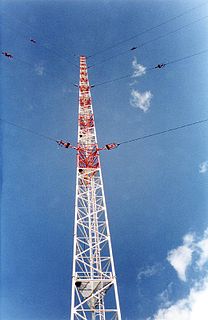
The Roumoules transmitter is the main broadcasting facility for longwave and mediumwave broadcasting of Radio Monte Carlo near Roumoules, France. The transmitters installed there are among the most powerful in the world and can be received well at nighttime throughout Europe.

The Mühlacker Broadcasting Transmission Facility is a radio transmission facility near Mühlacker, Germany, first put into service on November 21, 1930. It uses two guyed steel tube masts as aerials and one guyed steel framework mast, which are insulated against ground. It has two transmission aerials for shortwave and one free standing steel framework tower for directional radio services. The shortwave transmitter was shut off on October 19, 2004. The medium wave transmitter was switched off in January 2012.

The AM transmitter in Burg, near Magdeburg, Germany, is a huge facility for longwave and mediumwave broadcasting. Its most dominant constructions are a 324-metre guyed radio mast and two 210 metre guyed steel tube masts.

The Langenberg transmission tower is a broadcasting station that transmits MW, FM and TV signals. It is located in Langenberg, Velbert, Germany and has had a very turbulent history since its inauguration. The transmitter first went into service in 1927 with 60 kilowatts (kW) of power and a T-aerial hanging on two 100-metre freestanding steel-frame towers insulated against ground.
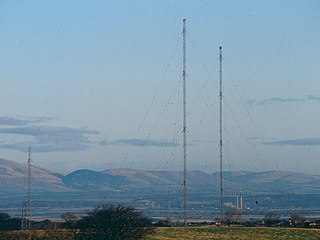
The Westerglen transmitting station is a facility for longwave and mediumwave broadcasting established in 1932 at Westerglen Farm, 3 km south west of Falkirk, Stirlingshire, Scotland.
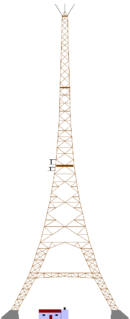
The Transmitter Ismaning was a large radio transmitting station near Ismaning, Bavaria, Germany. It was inaugurated in 1932. From 1932 to 1934 this transmitter used a T-antenna as transmitting antenna, which was spun between two 115-metre-high free-standing wooden lattice towers, which were 240 metres apart. As this antenna had an unfavourable vertical radiation pattern, which produced much skywave resulting in a too small fading-free reception area at night, in 1934 a new antenna was installed. Therefore, one of the towers was dismantled and rebuilt on a 39-metre-high (128 ft) wooden lattice base. While this work took place, an L-Antenna was used, which was spun between the other tower and a small auxiliary wooden tower. It became defunct in 1977 and was destroyed in 1983.

The Rheinsender is a large medium-wave transmission facility near Wolfsheim, southwest of Mainz for the frequency 1017 kHz. The Rhine transmitter was established in 1950 and went on the air May 15, 1950. It belongs to SWR and transmitted until the middle of the 1990s with 600 kilowatts. In the last years the transmission power was reduced to 100 kilowatts.
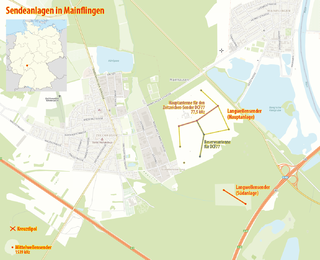
The Mainflingen mediumwave transmitter is a mediumwave transmission facility south of the A3 motorway near Mainflingen, Hesse, Germany. Mainflingen was the first mediumwave transmitter for the radio station Deutschlandfunk. It went into service in 1962 with a transmission power of 50 kW, on a frequency of 1538 kHz, at the upper end of the mediumwave band. This frequency has a bad groundwave propagation and therefore a low range at daytime, but an excellent skywave propagation with a long range at night.
The Monte Ceneri transmitter was first established as the nationwide medium-wave radio transmission station for Italian-speaking Switzerland in 1933. Located on Monte Ceneri in Ticino, it broadcast on a frequency of 558 kHz.

The Wavre radio transmitter is a facility for mediumwave, shortwave, FM and TV broadcasting near Wavre in Belgium. For the mediumwave transmissions it uses a grounded 250-metre-high guyed mast. Furthermore, there is a backup mast for medium wave transmissions, which is 90 metres high. For shortwave broadcasting several directional antennas and a curtain antenna are used. The towers are two of the tallest structures in Belgium.
The Domžale radio transmitter is a facility for medium wave broadcasting in Domžale, in Slovenia. The transmitter is fully transistorized. It could be received easily at a medium wave frequency of 918 kHz across the whole of Europe at night-time. It was the strongest radio transmitter of the Republic of Slovenia, broadcasting the first national radio channel.
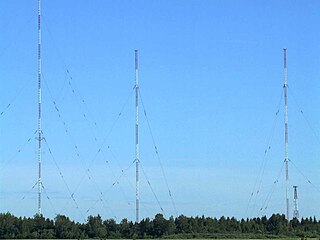
Sitkūnai Radio Station is a large facility for medium wave and shortwave broadcasting at Sitkūnai, Lithuania. The decision to build a new transmitting centre near the village of Sitkunai, about 17 km (11 mi) north of Kaunas was made by the Government of Lithuania in 1937. The building works started in 1939, and after completion, a 120 kW medium wave transmitter from Standard Telephones and Cables in the United Kingdom was ordered. However, the outbreak of World War II stopped the shipment. The empty transmitter buildings in Sitkunai survived the war with almost no damage and were used as military compound by the German army in 1941-1944, and later as a primary school. Because the Soviet Lithuania was badly covered by radio signals, the Soviet authorities decided to continue the building work at Sitkunai and turn the site into a main shortwave and medium wave transmitting centre. During 1951 and 1952 two 50 kW shortwave transmitters, dismantled from an East German utility site as war reparations were installed in Sitkūnai. Several curtain antennas were erected and one 150 kW mediumwave transmitter was installed (665 kHz). During the January Events in 1991, Sitkūnai Radio Station was among those transmitting sites broadcasting to the world about the Soviet military actions in Vilnius when 14 civilians were killed and more than 600 injured.

Löffelstelzen Transmitter is a broadcasting facility of SWR at Bad Mergentheim-Löffelstelzen in northern Baden-Württemberg, Germany. It was inaugurated at the beginning of the 1950s and used at those days a guyed mast, which was insulated against ground, because it was used for medium-wave broadcasting with a butterfly antenna for FM- and TV-transmission on its top. Later this mast was replaced by a concrete tower, which carried an antenna for FM-/TV-broadcasting on its top and a cage and a wire antenna for medium-wave broadcasting at its site. This tower was replaced between 1998 and 2000 by a 179 metre tall concrete tower. This tower is not equipped with an antenna for medium wave broadcasting, because this was ceased in 2000 at the Löffelstelzen transmission site.

The Wiederau transmitter is the oldest broadcasting facility in Saxony. It is located near Wiederau, a village which is part of the municipality of Pegau, and is used for medium-wave, FM and Television broadcasting.
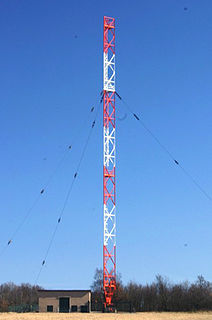
Marnach transmitter was a broadcasting facility of RTL near Marnach in the commune of Munshausen, in northern Luxembourg. The Marnach transmitter was built in 1955 for improving the transmission of the English-speaking program on 1439 kHz, which was transmitted from 1951 with an omnidirectional antenna from Junglinster, to the British Isles and for a better transmission on this frequency to Germany at daytime. Therefore, it was given a directional antenna with a switchable directional characteristic pointing North-northeast towards the Rhine-Ruhr area, Germany's most populated area, and West-northwest in the direction of the UK. This antenna was implemented in form of a directional antenna consisting of three ground-fed 105-metre tall guyed mast antennas arranged in the form of an isosceles triangle with a 90 degree angle. As transmitters, two 100 kW units switched in parallel were used when it went in service in December 1955.
Warszewo transmitter is a radio broadcasting facility at Warszewo, Szczecin, a suburb of Szczecin, Poland.
The NHK Kawaguchi Transmitter was a medium-wave broadcasting station at Kawaguchi, Saitama, Japan, which was built in 1937. It used for transmissions on 590 kHz with a power of 150 kW, a T-antenna, which was spun between two 312.78-metre-tall guyed masts, which were 463 m apart and which were both insulated against ground.
Berlin-Köpenick transmitter was a transmission facility for broadcasting on medium wave, short wave, and VHF in Berlin-Köpenick, Germany, near the suburb of Uhlenhorst, after which it was occasionally named.















